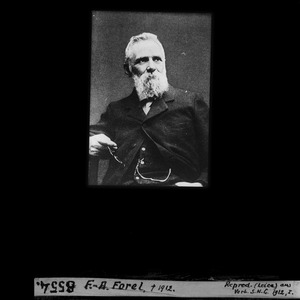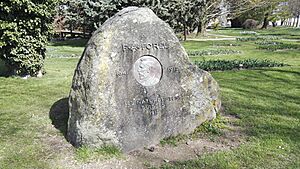François-Alphonse Forel facts for kids
François-Alphonse Forel (born February 2, 1841 – died August 7, 1912) was a Swiss doctor and scientist. He was the first person to really study lakes in a scientific way. Because of this, he is known as the founder, or "Father," of limnology. Limnology is the study of fresh water bodies like lakes and ponds. It looks at their living things, chemicals, and physical features.
Contents
Early Life and Family
Forel was born in Morges, Switzerland, right next to Lake Geneva. His father, François Marie Etienne Forel, was a respected historian and lawyer. He had a big influence on young François-Alphonse.
From a young age, Forel helped with some of the archaeological studies done by his father's friends. Many people in Forel's family were also well-known scholars and scientists.
His Education
Forel started his schooling at the Collège de Morges. Later, he went to a secondary school in Geneva called the Gymnase de Genève. There, he studied natural sciences and medicine.
He then attended the Académie de Genève. He earned degrees in literature and in physical and natural sciences. When he was 18, he left Switzerland to study at the Académie de Montpellier in France. He studied there for two years. After that, he spent time studying medicine on his own in Paris.
Later, he moved to Germany and studied at the University of Würzburg. In 1865, when Forel was 24 years old, he earned his doctorate degree in medicine. He also specialized in obstetrics, which is the study of childbirth.
His Work and Discoveries
Soon after getting his doctor's degree, Forel went back to Lake Geneva in Switzerland. He started his own deep study of the lake. This included looking at its animals, physics, chemistry, and biology. He even studied its natural history and how it affected the economy.
In 1869, he became a science professor at the University of Lausanne. This university was close to his home by Lake Geneva. He taught about tissues, body structure, and how living things work.
The Birth of Limnology
But Forel's true passion was the lake itself. He studied the biology and chemistry of the water. He also looked at how water moves and how sedimentation (stuff settling at the bottom) happens. Most importantly, he studied how all these things worked together.
His work laid the groundwork for a brand new field of science. He called this new study limnology. He chose this name because it was similar to oceanography, which is the study of oceans. He didn't use "limnography" because it sounded too much like a tool that measures lake levels.
Key Publications and Discoveries
Forel's most important work was a book called Le Léman. It was published in three parts between 1892 and 1904. These books covered many topics. They defined what limnology was. They also described the geography, geology, and climate around lake systems. He wrote about how water moves in lakes, including seiches (water sloshing back and forth) and currents. He also covered water temperature, light, sound, and chemistry in lakes.
He discovered something called density currents in lakes. These are currents caused by differences in water density. He also explained seiches, which are like standing waves that make the water level in a lake go up and down rhythmically.
Forel also studied the Fata Morgana. This is an optical illusion, a type of mirage, that can be seen over Lake Geneva and other places. It makes distant objects look stretched or stacked.
Other Scientific Contributions
Forel worked with another scientist, Wilhelm Ule. Together, they created the Forel-Ule scale. This scale is used to figure out the color of a body of water.
In a completely different area, he worked with an Italian scientist named Michele Stefano de Rossi. They developed the Rossi–Forel scale. This scale helps describe how strong an earthquake is.
Legacy and Recognition
By the time Forel died in 1912, he had written 288 scientific papers. His knowledge was so vast that a magazine called Nature referred to him as "the Faraday of Lakes." This compared him to the famous scientist Michael Faraday.
He was highly respected by scientists in Scotland. He visited there at least once. He was also made an honorary member of the Royal Society of Edinburgh.
Many things have been named after Forel to honor his contributions:
- The Institute F.-A. Forel at the University of Geneva is named after him.
- Foreltinden, a mountain in Spitsbergen, Svalbard, carries his name.
- A train station called Forel (station) in Maule, Chile is also named after him.
- The submersible F.-A. Forel (PX-28) is named in his honor. This special submarine has been used to take scientific measurements in Lake Geneva.



